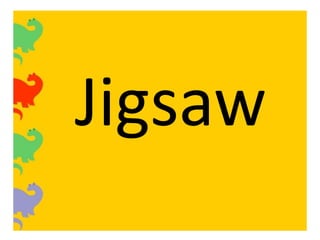Jigsaw
- 1. Jigsaw
- 2. What is Jigsaw? Jigsaw is a cooperative learning strategy that enables each student of a “home” group to specialize in one aspect of a learning unit. Students meet with members from other groups who are assigned the same aspect, and after mastering the material, return to the “home” group and teach the material to their group members.
- 3. Just as in a jigsaw puzzle, each piece-each student's part--is essential for the completion and full understanding of the final product. If each student's part is essential, then each student is essential. That is what makes the Jigsaw instructional strategy so effective.
- 4. What is its purpose? • Jigsaw learning allows students to be introduced to material and yet maintain a high level of personal responsibility. • to develop teamwork and cooperative learning skills within all students. • it helps develop a depth of knowledge not possible if the students were to try and learn all of the material on their own.
- 5. • Finally, because students are required to present their findings to the home group, Jigsaw learning will often disclose a student’s own understanding of a concept as well as reveal any misunderstandings.
- 6. How can I do it? • Each student receives a portion of the materials to be introduced; • Students leave their "home" groups and meet in "expert" groups; • Expert groups discuss the material and brainstorm ways in which to present their understandings to the other members of their “home” group;
- 7. • The experts return to their “home” groups to teach their portion of the materials and to learn from the other members of their “home” group. • Involve the class in a whole-group review of all the content you expect them to master on the assessment. Administer an individual assessment to arrive at individual grades.
- 8. Students will need to evaluate themselves on how well their group did in the jigsaw (e.g., active listening, checking each other for understanding, and encouraging each other) and set goals for further interaction.
- 9. Assessment & Evaluation Considerations Assess students' degree of mastery of all the material. Reward the groups whose members all reach the preset criterion of excellence or give bonus points on their individual scores if this criteria is met.
- 10. What is Cooperative Learning? Cooperative learning is an instructional strategy that simultaneously addresses academic and social skill learning by students. It is a well-researched instructional strategy and has been reported to be highly successful in the classroom. For a more in depth explanation of this strategy, follow this link to the self-guided tutorial.
- 11. What is its purpose? • There is an every increasing need for interdependence in all levels of our society. • One way of providing students with a well defined framework from which to learn from each other. • Students work towards fulfilling academic and social skill goals that are clearly stated. • It is a team approach where the success of the group depends upon everyone pulling his or her weight.
- 12. How can I do it? • Student groups are small, usually consisting of two to six members. • Grouping is heterogeneous with respect to student characteristics. • Group members share the various roles and are interdependent in achieving the group learning goal. • While the academic task is of primary importance, students also learn the importance of maintaining group health and harmony, and respecting individual views.
- 13. How can I adapt it? Five Basic Elements of Cooperative Learning 1. Positive Interdependence 2. Face-To-Face Interaction 3. Individual Accountability 4. Social Skills 5. Group Processing
- 14. Cooperative learning can take place in a variety of circumstances. For example, brainstorming and tutorial groups, when employed as instructional strategies, provide opportunities to develop cooperative learning skills and attitudes.
- 15. Assessment and Evaluation Considerations Observing cooperative learning groups in action allows you to effectively assess students' work and understanding. Cooperative learning groups also offer a unique opportunity for feedback from peers and for self-reflection.
- 16. COOPERATIVE GROUP PROCESSING Names:_______________________&__________________ Date____/____/19___ Topic of study:_____________________________________ As a team, decide which answer best suits the way your team worked together and complete the remaining sentences. 1. We finished our task on time, and we did a good job! YES NO 2. We encouraged each other and we cooperated with each other. YES NO
- 17. 3. We used quiet voices in our communications. YES NO 4. We each shared our ideas, then listen and valued each others ideas. YES NO 5. We did best at_____________________________________ _______________ 6. Next time we could improve at ______________________________________

